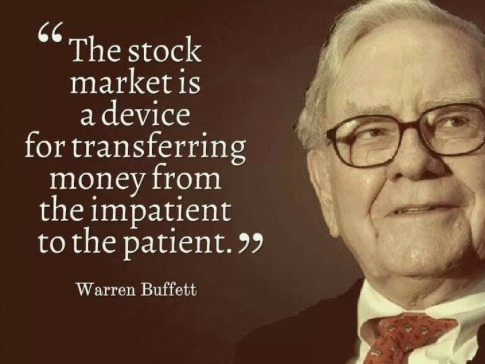My Conversations With Gene:
What my financial advisor taught me about investing, Warren Buffett and ignoring headlines:

Warren Buffett loves trains—not just because it gives him time to play bridge with such luminaries as Bill Gates—but because it gives him a unique perspective on investing. One time he noticed a rail yard full of box cars. That activity convinced him to buy stocks in Union Pacific, Norfolk Southern, and later make a major investment position in Burlington Northern Santa Fe.
He’s done the same thing travelling across America’s heartland, seeing harvests, seeing industrial complexes, seeing ships coming into port. From those observations, he’s made some of the most important investment decisions of his career (many paying big returns other investors missed!).
Now, before you go jumping on the train (not that I’m discouraging it; trains are great), let’s look at what Buffett doesn’t see. What he doesn’t see, and what he takes great pains to avoid, is the barrage of headlines, the inflamed and sensationalist rhetoric being pumped out by the media.
In other words, the real genius of Buffett’s investment strategies is engaging in what’s there, not what the pundits and hype-grabbers say is there.
Too often, what the media wants us to know isn’t necessarily in the best interest of our portfolios. They focus on crisis, on the pattern of constant geo-political threats, on what could be called apocalypse du our. This type of journalism is designed to stir us, to make us worry, to be concerned. Certainly we need to be aware of the world at large, but that’s also when we make hasty investment decisions instead of prudent ones.
Successful investors, on the other hand, have the uncanny ability to “turn off” the headline noise, keeping their attention on sound economic fundamentals. More importantly, they exploit it. This is key to investment strategies, particularly those that can be seen from ground level, like from the window of a train.
Let’s go back to 2009 when Warren Buffett took out a full-page ad in the NY Times. At the time, nobody was particularly bullish about stocks. The S&P 500 was sitting at 725. Despite the headlines of doom and gloom (maybe even because of them), Buffett decided this was exactly the time to invest. The headline said it all: “I AM BUYING AMERICAN COMPANIES.”
Was Buffett being overly optimistic or perhaps patriotic? Acute investors knew otherwise. Like any market upswing, you get in at the trough, and Buffett was convinced there was nowhere to go but up. That wasn’t optimism, that was pure logic. And he was right.
Sometimes it’s just experience, the years that make you more attuned to market fluctuations and their real cause. Buffett certainly has the experience and years, but I also believe he has “light bulb moments.” Sometimes those “light bulb moments” can challenge everything you’ve stood for or believe in.
Let’s go back to that rail yard story again as an example. Why would a man who didn’t consider railways competitive, go on to buy 845,000 shares of Burlington Northern Santa Fe (at $72.75 a share)? He saw with his own eyes the number of box cars, all full, all going to destinations. He couldn’t deny the obvious. There was movement, and with movement, there were profits. As simple as this sounds, his investments in railroads have paid big dividends.
That’s what I call a “light bulb moment,” and I had my own back in 1998. I was passionate about mutual funds. All my money, my parents’ money, even my friends’ money was in mutual funds. I was convinced there was no better alternative in the market because of their diversification.
A year later, while teaching an intermediate financial planning course at Glendon College, York University, I met a mathematics professor who asked for a portfolio review. As you would expect, given his technical background, he kept track of every data point and ratio of each company.
Surprisingly this professor had limited his portfolio strictly to dividend paying companies like banks, oil and gas, utilities, consumer staples and so on. It was actually very small, just 12-15 in total, and was made up of mostly Canadian operations.
On one hand, you could say it was boring, on the other it was prudent. Sure, it defied conventional wisdom at the time, but it identified and essentially capitalized on certain growth sectors. More importantly, it focused on dividend growth.
The investment return of this simple portfolio was eye-popping. It had an average annual return of over 20%, spanning twenty-five plus years.
I spent the next several hours learning the specifics of his approach, trying to absorb as much about his discipline and process. This was followed up by many coffee meetings over the next several months. I was now his student.
In many ways, this became my strategy: a relatively small list of established stocks, all focused on solid fundamentals and dividend growth.
In some respects, I’d met someone with the same attuned knowledge, the same practical application Warren Buffett adopted from that train window. It defies conventional wisdom, but ignoring the headlines, the hype-grabbers and the media in general, isn’t such a bad thing.
I’d advise everyone to do the same. It may not be conventional, but as Buffett once pointed out “All the indications are there if you bother to look.”
Today, I’m convinced dividend growth investing is the way to go, especially given the slow recovery we’re seeing today. We’ve been through periods like this before (actually for centuries). As long as investors stick to solid companies, taking their time, they’ll see their portfolios grow substantially. Here’s what you need to remember with any dividend focused portfolio:
1) Dividends lower investment risk as the dividend cushions the decline.
2) Dividends dominate the components of total return.
3) Study after study proves that dividend growth investing outperforms most other approaches.
4) Dividends provide the ability to achieve positive returns even when markets are unfavorable.
5) Dividend payments are a regular barometer of a company’s health.
6) Dividends can provide investors sufficient retirement income despite the bouncing principal.
If you liked this piece and found it helpful, why don’t you contact Gene Giordano and let him know: gene.giordano@scotiawealth.com
"
Articles from Robert Cormack
View blog
Fuck. · “I thought about reading a poem by Shakespeare, but then I thought, why should I? He never r ...

This is the latest issue of Rosebud Magazine (#69), marking my twenty-year relationship with publish ...

“Sayin' ball of confusion, that's what the world is today, hey, hey.” Norman Whitfield and Barrett S ...
You may be interested in these jobs
-
Électricien de maintenance
Found in: Talent CA C2 - 3 days ago
Ainsworth Montreal, CanadaDescription · Position at Montreal GDI Si vous voulez évoluer dans un milieu de travail axé sur l'esprit d'équipe, un environnement qui met au défi vos compétences, favorise le développement de votre carrière, favorise la diversité et récompense l'innovation, avec des salaires ...
-
Rail Track Maintainer
Found in: beBee S2 CA - 3 weeks ago
CN Rail Fort Nelson, Canada OTHERRail Track Maintainer · Enjoying physical labour and working outdoors as well as being safety-minded are vital to a career in rail operations at CN. If you like being part of a team and working in different locations every day, a rewarding career in track maintenance will appeal ...
-
window installer
Found in: Talent CA 2 C2 - 22 hours ago
Procon Contracting Ltd. Calgary, CanadaEducation: · Expérience: · Education · No degree, certificate or diploma · Tasks · Determine layout and installation procedures · Measure and mark guidelines to be used for installations · Load and unload trucks with supplies and equipment · Utilize hand and power tools · Insta ...



Comments